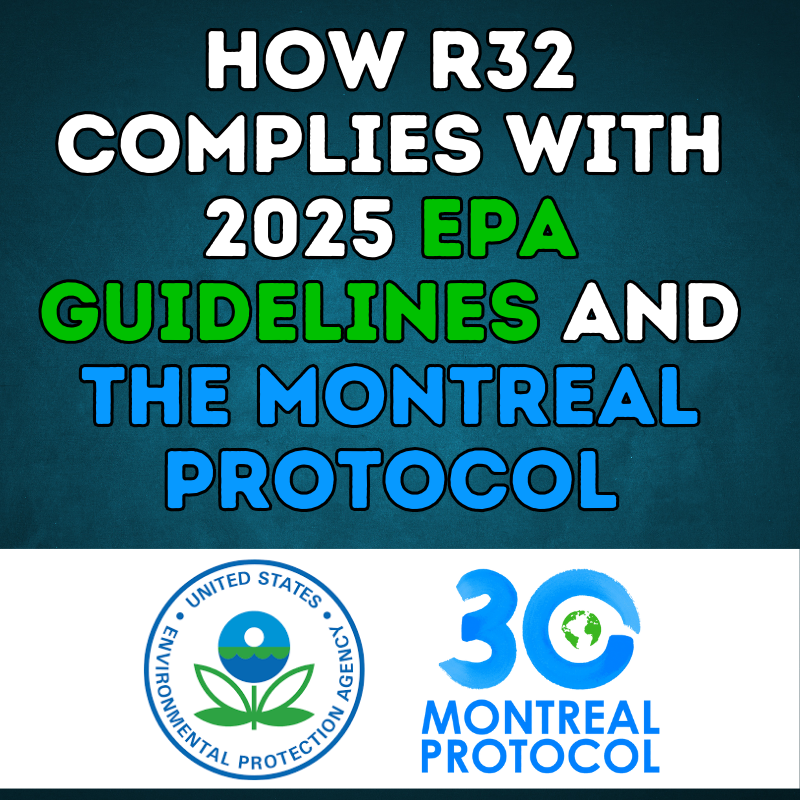As global concerns about climate change and environmental sustainability continue to grow, regulations surrounding refrigerants have become increasingly stringent. Two major frameworks shaping these regulations are the U.S. Environmental Protection Agency's (EPA) 2025 guidelines and the Montreal Protocol. Both of these regulatory frameworks aim to reduce the environmental impact of refrigerants, particularly those with high global warming potential (GWP) and ozone-depleting characteristics. R32, a newer refrigerant, is emerging as a key player in meeting these environmental standards.
The Montreal Protocol: A Global Commitment
The Montreal Protocol, adopted in 1987, is a landmark international treaty designed to protect the ozone layer by phasing out the production and consumption of ozone-depleting substances (ODS). Initially focused on chlorofluorocarbons (CFCs) and hydrochlorofluorocarbons (HCFCs) like R22, the protocol has been amended over the years to address other harmful substances, including hydrofluorocarbons (HFCs) like R410A, which, while not ozone-depleting, have high GWPs.
In 2016, the Kigali Amendment to the Montreal Protocol was introduced, focusing specifically on reducing HFCs, which are powerful greenhouse gases. The Kigali Amendment sets clear targets for the gradual reduction of HFCs, aiming for a significant cut in their production and use by 2036. As part of this effort, the search for alternative refrigerants that are both environmentally friendly and compliant with international agreements has intensified, with R32 being a standout option.
EPA 2025 Guidelines: A U.S. Perspective

Discover Top-Grade Air Conditioners: View Our Products Today
Under the 2025 guidelines, manufacturers and consumers are encouraged to transition to refrigerants that offer lower GWPs while maintaining efficiency and safety. The EPA’s push for more sustainable refrigerant options is part of a larger strategy to mitigate climate change and reduce the carbon footprint of HVAC systems across the country.
R32: A Refrigerant for the Future
R32 is a hydrofluorocarbon (HFC) refrigerant that has gained significant attention for its environmental benefits and compliance with both the Montreal Protocol and EPA guidelines. Here’s how R32 meets and exceeds these regulatory standards:
-
Lower Global Warming Potential (GWP):
R32 has a GWP of 675, which is significantly lower than that of R410A, which has a GWP of 2,088. This lower GWP makes R32 a much more environmentally friendly option, as it contributes less to global warming if released into the atmosphere. The reduction in GWP is a crucial factor in meeting the EPA’s 2025 guidelines, which emphasize the importance of minimizing the climate impact of refrigerants. -
Zero Ozone Depletion Potential (ODP):
Like R410A, R32 has zero ozone depletion potential, meaning it does not harm the ozone layer. This characteristic is critical for compliance with the Montreal Protocol, which prioritizes the protection of the ozone layer by eliminating the use of ODS. R32’s zero ODP ensures that it meets the stringent requirements set forth by the protocol. -
Improved Energy Efficiency:
R32 is more efficient in heat transfer compared to R410A, which means that HVAC systems using R32 can achieve the same or better cooling performance with less energy. This increased efficiency not only reduces energy consumption but also helps in lowering greenhouse gas emissions, further aligning with the environmental goals of the Montreal Protocol and EPA’s guidelines. -
Compatibility and Safety:
R32 is compatible with the existing HVAC infrastructure, making it easier for manufacturers to transition from R410A to R32 without significant redesigns. Additionally, while R32 is classified as mildly flammable (A2L), its safety risks are manageable with proper handling and installation, making it a viable option under the EPA’s 2025 guidelines.
The Industry Shift Toward R32
The shift towards R32 is already underway, with many HVAC manufacturers adopting R32 in new systems to comply with upcoming regulations. This transition is not just about regulatory compliance; it’s also about preparing for the future. As more countries adopt stricter environmental standards and as global temperatures continue to rise, the demand for refrigerants that can deliver both performance and sustainability will only grow.
R32 is positioned as a key refrigerant for this new era, offering a balance of environmental responsibility, energy efficiency, and safety. By choosing R32, manufacturers, and consumers alike can contribute to global efforts to reduce greenhouse gas emissions and protect the environment, all while enjoying the benefits of a modern, efficient HVAC system.
R32 as a Compliance and Sustainability Solution
As we approach 2025, the importance of selecting the right refrigerant becomes increasingly clear. R32 stands out as a refrigerant that not only complies with the EPA’s guidelines and the Montreal Protocol but also offers superior performance and environmental benefits. Its low GWP, zero ODP, and improved energy efficiency make it a smart choice for those looking to stay ahead of regulatory changes while contributing to a more sustainable future. If you’re looking for an R32 product coming soon we suggest the Goodman 3 Ton 16.4 SEER2 R32 Air Conditioner Condenser.







